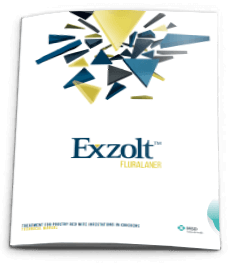Pharmacology
After oral administration, fluralaner is absorbed rapidly from the medicated drinking water, reaching maximum plasma concentrations 36 hours after the first administration and 12 hours after the second one. The bioavailability is high, with approximately 91% of the dose absorbed following oral administration.
- Fluralaner is a very potent acaricide, acting extremely fast (within 4 hours) and for at least 15 days when the recommended Exzolt dosage regimen is administered to chickens affected by Poultry Red Mites (D. gallinae) and Northern Fowl Mites (O.sylviarum).
- Fluralaner is highly bound to protein and widely distributed throughout the body, with the highest concentrations reported in the liver and skin/fat.
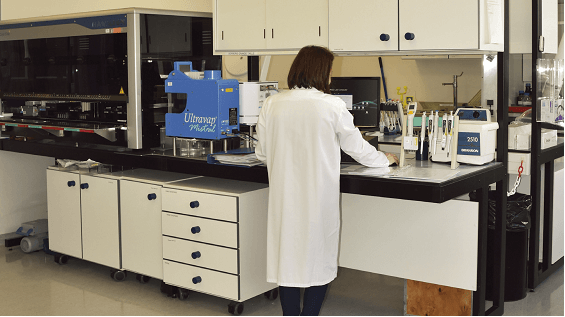
- Exzolt significantly impairs reproduction of D. gallinae. During the first 15 days posttreatment, all mites died within 24 hours without laying any eggs, and after 19 days, mite reproduction was still seriously limited due to a remaining killing effect on female mites combined with a reduction of their oviposition, thus limiting development of any less sensitive mite stages from eggs.
- No resistance for fluralaner has been detected in field isolates, and fluralaner was active in vitro against mite isolates that were resistant to other acaricides.
- The Exzolt treatment regimen (2 administrations 7 days apart) provides acaricidal activity for a duration sufficient to break 2 consecutive mite life stages, thus providing a complete elimination of mite population in the building and thus limiting development of resistance.
Pharmacodynamics and Activity
In preliminary research regarding fluralaner pharmacodynamics and activity, fluralaner demonstrated a prominent feeding activity against Dermanyssus gallinae compared to a less potent contact activity, which is appropriate for an orally administered drug with a systemic mode of action (Figure 3-2).1 Another study evaluated the susceptibility of nymph and adult mites to fluralaner, using an immersion test.1 Fluralaner was highly active in vitro against both nymph (LC90=0.38 ppm) and adult (LC90=0.52 ppm) mite stages.
The primary pharmacodynamic study of interest evaluated the speed of kill and the impact of treatment on reproductive capacity of mites after feeding on Exzolt-treated hens.
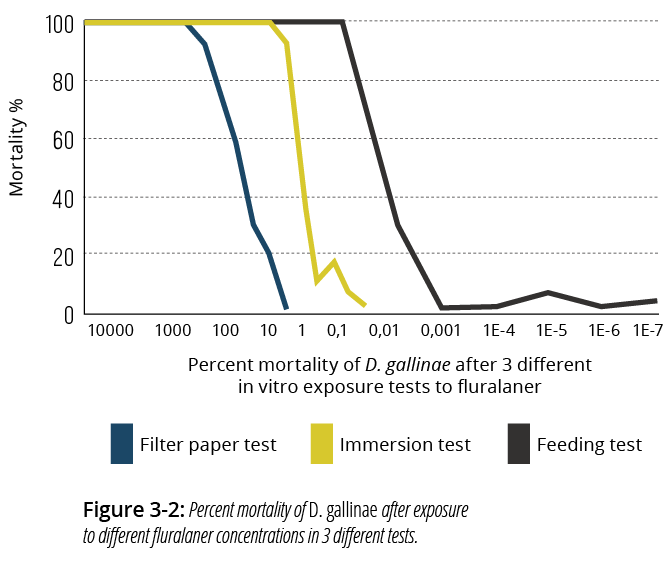
Study Design
- 16 laying hens (~ 20 weeks of age) were randomly allocated to 2 groups of 8 hens housed in 2 separate pens. One group was treated on days 0 and 7 with Exzolt at the recommended dose of 0.5 mg fluralaner/kg BW while the second group remained unmedicated (controls).
- Six hens of each group were artificially infested with unfed D. gallinae (mainly adults) on multiple occasions between days 1 and 26. After each infestation, a sample of engorged mites were collected from each infested hen, incubated, and assessed for mortality after 4, 8, 12, and 24 hours.
- For the reproductive portion of the study, tubes containing mite eggs, surviving mites, or both were incubated for 8 additional days. Counts of dead adult male and female mites, mite eggs, larvae, and nymphs were performed daily.
- The primary reproduction parameter was the control of nymphal development (i.e., control of the capability to finally reproduce into nymphs as the first blood-sucking development stage). The conversion from each mite stage to the next was also determined, including the number of eggs laid per incubated female (fertility) and hatchability rate.
RESULTS
Outcomes for the speed-of-kill portion of the study (Figure 3-3) indicate that the mortality of mites infested on day 1 was 100% by 4 hours post-infestation, while the mortality of mites infested on day 5 was 98.7% at 4 hours and 100% at 8 hours.
After the second oral Exzolt treatment of hens on day 7, mortality of mites infested on day 8 was again 100% at 4 hours, and at day 12 near complete mite mortality (98.7-100%) was still observed within just 4 hours of mites feeding on treated hens. Notably, 100% mortality was observed within 24 hours for all mite infestations through day 15, without any oviposition. These impressive outcomes are related to the fact that mites feed on birds for a very short time (30-90 minutes), absorbing a high amount of fluralaner during this period. By day 19, mite mortality 24 hours post-infestation was 74.8% and the oviposition (eggs laid within 24 hours) was reduced 82.2% vs. controls.
Nymph emergence (an indicator of reproductive success) was completely inhibited in treated hens through day 15, and reduction was still 90.8% at day 19 vs. controls (Figure 3-4). Fertility of surviving females (control of eggs laid) was impaired mainly for mites infested on day 19 (48.1% reduction, Figure 3-4). The oral administration of Exzolt was well tolerated in all hens, with no treatment-related adverse reactions observed in treated birds.
CONCLUSION
The treatment of hens with Exzolt led to profound and fast mite mortality for at least 15 days. Furthermore, the demonstrated fast onset of action resulted in an immediate interruption of the reproduction of the affected female mites prior to the lethal effect. Even 12 or 15 days after the second Exzolt treatment (days 19 and 22), the medication still demonstrated major impacts on the ability of surviving females to produce the next parasitic mite generation (nymph emergence). Ongoing mortality of incubated mites combined with a reduction of laid eggs are the main factors responsible for reduced reproduction of the mites (nymph emergence). Molting processes of the mite progeny were not notably impacted by fluralaner.
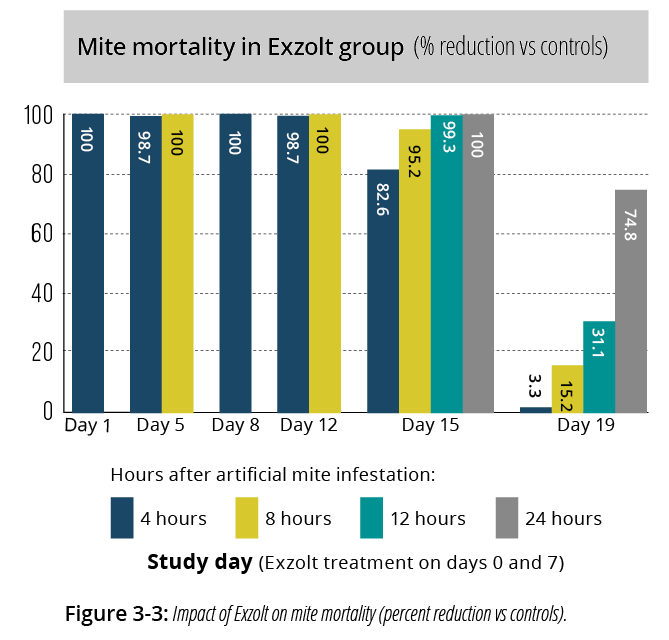
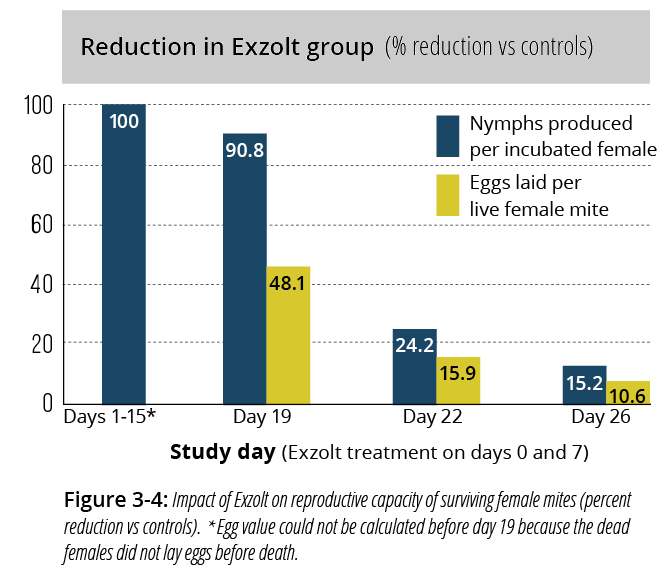
1 Data on file. MSD Animal Health.
Technical Manual
The development and approval of Exzolt (fluralaner) solution for treatment via drinking water now offers an unparalleled approach for management of poultry red mites in chickens. The Exzolt Technical Manual provides useful and comprehensive information about this cost-effective and revolutionary product.
